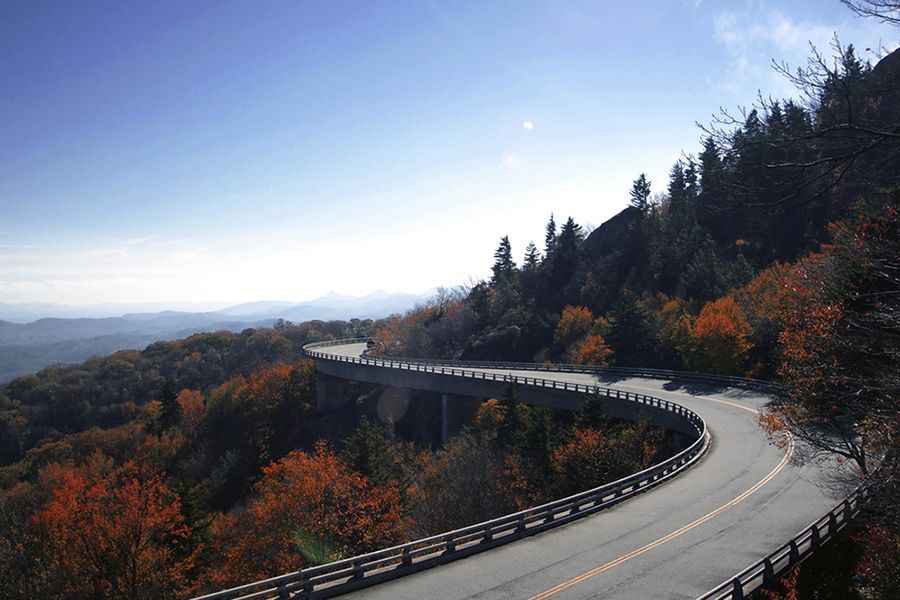Blue Ridge Parkway is one of the most scenic drives in the USA
Blue Ridge Parkway is a very scenic drive spanning Virginia and North Carolina, in the USA. Featuring unparalleled views of American beautiful landscapes, it’s one of the most scenic drives in the USA.

Where does Blue Ridge Parkway begin and end?
The road is totally paved. It’s 755 km (469 miles) long, running from Shenandoah National Park in the northern Shenandoah Valley of Virginia to the Great Smoky Mountains National Park in North Carolina. It runs through 29 Virginia and North Carolina counties and was completed in 1987. There is no admission fee and there are 26 tunnels constructed along the road.
Is the Blue Ridge Parkway open?
The road is typically open all year round, with the occasional closure in winters due to dangerous weather conditions (ice and snow) or storm damage. Weather-related closures can change quickly during the winter. Much of the parkway is located at high elevation following the ridge of the Blue Ridge Mountains and the road tops out by Richland Balsam, at 1.845m (6,053 feet) above sea level.
Is driving the Blue Ridge Parkway scary?
Known as “America’s Favorite Drive”, the drive is not difficult. However, it features steep sections, tight curves and the Parkway's road shoulders are narrow in places. Extra care needs to be taken, especially on motorcycles. The first thing visitors might notice on the Blue Ridge Parkway is the lack of big rigs. That's because commercial trucking is banned on the road. There are some exceptions to the rule, however. If a trucker has to deliver goods to a business on the road they are permitted. Drivers will also notice the parkway is very narrow in some parts and there are a lot of sharp curves. If a visitor is from a flat state like Florida, this might be slightly terrifying at first. However, there are plenty of areas that allow amateur mountain explorers to pull off and collect themselves. While they do that, they can enjoy the magnificent views of the Appalachians.
How long does it take to drive the entire Blue Ridge Parkway?
Providing opportunities for enjoying all, to drive the road without stopping will take most people between 10 and 12 hours. However, due its beauty, the drive will take longer. So, allow 2-3 days to complete the whole drive with some stops on the way. The drive boasts some of the most spectacular scenery in the world and welcomes more than one million visitors annually.
What is Blue Ridge Parkway known for?
Visitors to the Blue Ridge Parkway will not be disappointed by the splendid scenery. Everyone should try to visit the Blue Ridge Parkway at least once in their lifetime. In the fall, the parkway looks like it's on fire as the leaves of the trees change from green to vibrant reds, oranges, and yellows. It's magnificent. Stretching 469 miles, the Blue Ridge Parkway is said to be the nation's longest parkway. Named after the Blue Ridge Mountains, the drive welcomes more than one million visitors annually.
Waterfalls, waterfalls, and more waterfalls
Tourists who want to view cascading water, are going to be really excited. There are 12 waterfalls accessible off of the road. Below we've listed their names and locations.
- Cascades: milepost 271.9
- Wigwam Falls: milepost
- White Rock Falls: milepost 19.9
- Boone Fork Falls: milepost 296.4
- Linville Falls: milepost 316.4
- Crabtree Falls: milepost 339.5
- Apple Orchard Falls: milepost 78.4
- Douglas Falls: milepost 364.6
- Fallingwater Cascades: milepost 83.1
- Graveyard Fields Waterfalls: milepost 410
- Glassmine Falls: milepost 361.2
- Duggers Creek Falls: milepost 316.4
Oldest River
Milepost 199.5 of the Blue Ridge Parkway is home to the New River, which ironically is the oldest river in North America. It flows through West Virginia, Virginia, and North Carolina.
Animals, Plants, and Trees
In addition to rivers, waterfalls, vast forestland and beautiful scenic cliffs, the land along the Blue Ridge Parkway is full of animals. Visitors might see white-tailed deer frolicking in the woods. They could even run into a black bear, although, we hope those creatures stay away. Wild turkeys, elk, beavers, river otters, and many other animals can all be found in the habitats surrounding the parkway. In addition to the abundant wildlife, the Appalachians are home to more than 1,400 species of vascular plants. There is even a bloom calendar that allows visitors to check out the best time of the year to find specific plants.
Image credit: Depositphotos